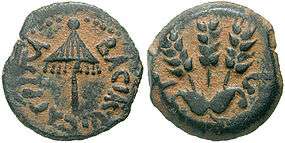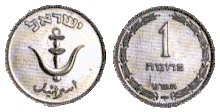Prutah
Prutah (Hebrew: פרוטה) is a Hebrew term, possibly derived from Aramaic, that appears in the Mishnah and the Talmud. It refers to a small denomination coin.


Obv: Double cornucopia.
Rev: Five lines of ancient Hebrew script; reading "Yehochanan Kohen Gadol Chever Hayehudim" (Yehochanan the High Priest, Council of the Jews)
History
Antiquity
The prutah was an ancient copper Jewish coin with low value. A loaf of bread in ancient times was worth about 10 prutot (plural of prutah). One prutah was also worth two lepta (singular lepton), which was the smallest denomination minted by the Hasmonean and Herodian Dynasty kings.
Prutot were also minted by the Roman Procurators of the Province of Judea, and later were minted by the Jews during the First Jewish Revolt (sometimes called 'Masada coins').[1]
State of Israel

In modern times, the pruta was a denomination of currency in Israel.
The prutah was introduced shortly after the establishment of the state of Israel, as the 1000th part of the Israeli pound. It replaced the mil, which was the 1000th part of the Palestine pound, a currency issued by the British Mandate of Palestine prior to May 1948.
The prutah was abolished in 1960, when the Israeli government decided to change the subdivision of the Israeli pound into 100 agorot. This move was necessary due to the constant devaluation of the Israeli pound, which rendered coins smaller than 10 prutot redundant.
See also
- Hasmonean coinage
- Coins of Alexander Jannaeus
- Herodian coinage
- Roman Procurator coinage
- First Jewish Revolt coinage
- Bar Kochba Revolt coinage
- List of historical currencies
- Gerah
- Zuz
References
- Prutah on Biblicalmites.com Archived 2006-01-27 at Archive.today